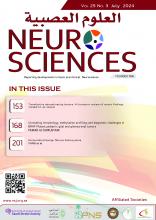Article Figures & Data
Tables
Monitoring parameter When Bradycardia At least 6 hours after first dose Pulse and blood pressure Hourly during observation Electrocardiograms (ECGs) Prior to dosing and at end of observation Ophthalmic examinations Before and 3–4 months after treatment Liver transaminase and bilirubin levels Before initiation of therapy and within 6 months of initiation Complete blood cells (CBC) During treatment and for 2 months after discontinuation Variables Frequency (n) Percent (%) Age (Mean (SD)) 34.82 (11.36) Gender Male 56 40.0 Female 84 60.0 Comorbidities Diabetes mellitus 4 2.86 Blood disorder 2 1.43 Skin cancer 1 0.71 Arrhythmia 4 2.86 - Table 3
- Clinician adherence categories based on following manufacturer’s recommendations.
Clinician adherence classification Number of clinicians Percentage Poor adherence (1 or no recommendation was followed) 72 (51.43) Moderate adherence (2-3 recommendations were followed) 65 (46.43) Full adherence (all recommendations were followed) 3 (2.10) Variables Applied or not n (%) Observe all patients for bradycardia for at least 6 hours; monitor pulse and blood pressure hourly. Electrocardiograms (ECGs) prior to dosing and at the end of observation period required. Yes 113 (80.7) No 27 (19.3) Ophthalmic examinations before and 3–4 months after start of treatment to assess for macular edema. Yes 22 (15.7) No 118 (84.3) Liver transaminases (aspartate transaminase and alanine transaminase) plus total bilirubin levels should be available before initiation of therapy and obtained within 6 months of Fingolimod initiation. Yes 77 (55.0) No 63 (45.0) Obtain complete blood cells, monitor for infection during treatment and for 2 months after discontinuation. Yes 12 (8.6) No 128 (91.4) Complication Number of patients affected Bradycardia with first dose 18 out of 113 monitored patients Macular edema 4 out of 22 monitored patients InfectionUrinary tract infection 4 out of 12 monitored patients Liver enzyme elevation
AST (Mean ± SD) (U/L) 87±99.1
ALT (Mean ± SD) (U/L) 158±163.4
Total bilirubin (Mean ± SD) (ummol/l) 11.5±11.36 out of 77 monitored patients - Table 6
- The impact of clinician adherence to fingolimod instructions on patient treatment.
Impact of clinician adherence Poor adherence Moderate adherence Full adherence P-value Treatment incompleteness 10 4 3 0.0001* Non-compliance 65 64 2 0.024*






